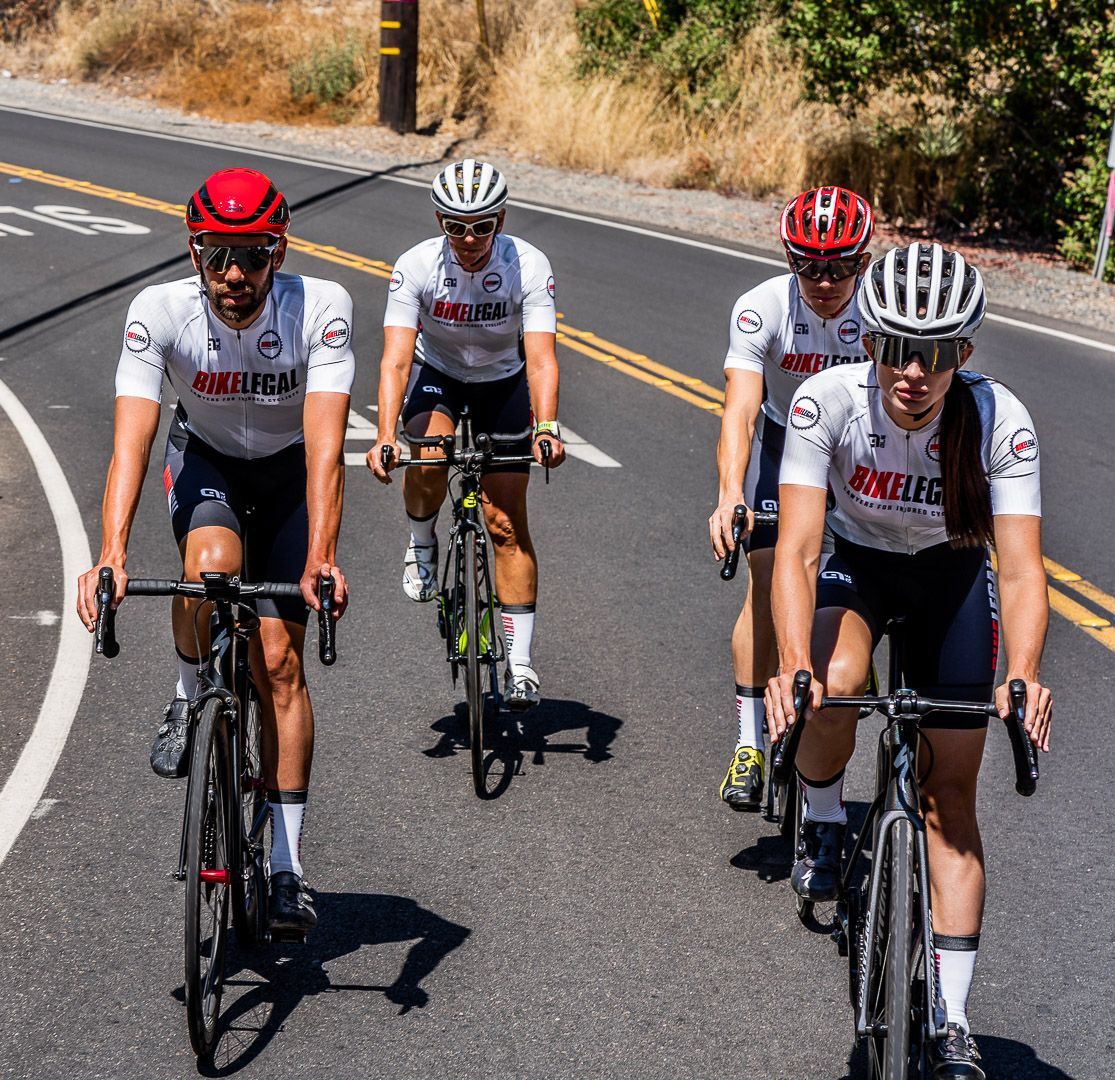2022 Bicycle Injury & Fatality Statistics (2024 Data): Cyclist Deaths On The Rise in the U.S.
Follow us on
social media!
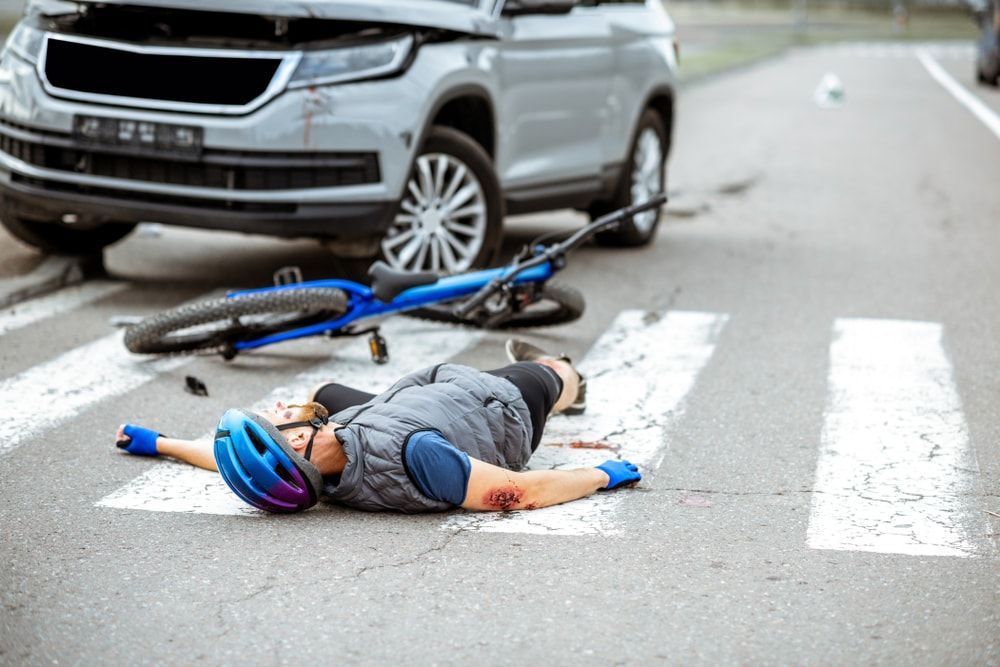
In 2022, 1,105 cyclists lost their lives in US bicycle accidents, a figure up by 13% from the previous year. For the first time, this count includes bicyclist fatalities involving E-bikes, previously categorized under motor vehicles.
Although overall roadway deaths decreased, the proportion of bicyclists killed saw a significant rise, indicating a growing risk for the biking community. This tragic upward trend serves as a wake-up call to cyclists, drivers, and policymakers alike. Despite growing awareness, our streets remain disproportionately unsafe for those choosing two wheels over four.
In this hard-hitting look at bicycle fatality statistics, we'll explore:
- The alarming annual death toll and how it stacks up against other modes of transportation
- Common causes behind these preventable tragedies - from vehicle collisions to risky rider behavior
- Demographic breakdowns revealing who's most at risk when cycling
- Real-world examples of accident types like car-door crashes and hit-and-runs
- Critical safety laws that could help reverse the deadly trend
- Actionable tips for cyclists and drivers to co-exist safely on the road
2022 Became America's Deadliest Year for Cyclists...By Far
The latest bicycle fatality report from the National Highway Traffic Safety Administration (NHTSA) highlights the need for change. An estimated 1,105 cyclists were killed in traffic accidents across the U.S. in 2022 - a staggering 13% spike from 2021's tally of 935 bicyclist deaths.
2022 Key Statistics
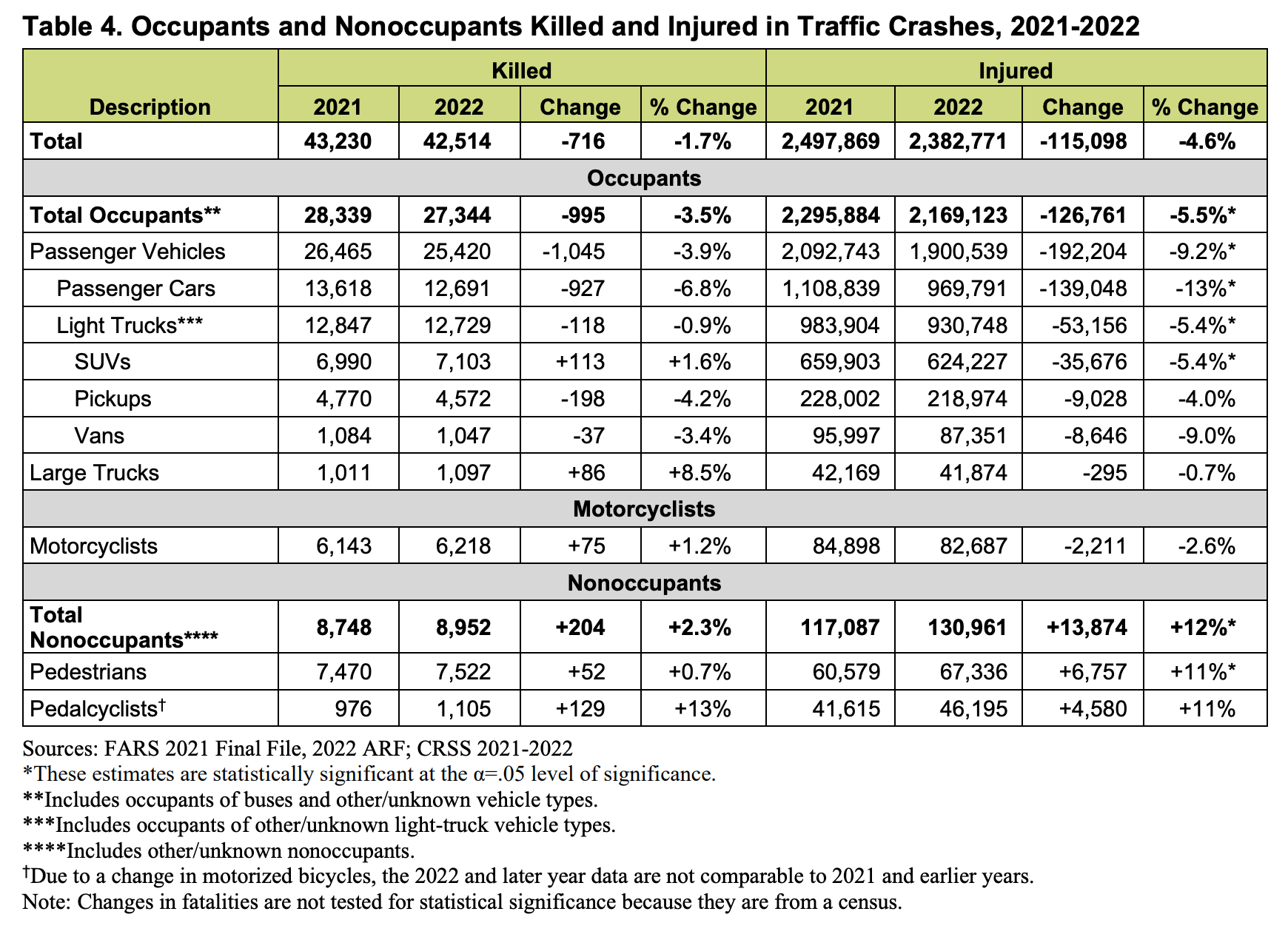
- A total of 1,105 cyclists, including e-bike riders, were killed in crashes with motor vehicles in 2022 - the highest number on record.
- Out of these 1,105 fatalities, an estimated 980 deaths (89%) involved collisions directly caused by car drivers.
- The 1,105 bicyclists killed in 2022 represent a 13% increase from the 976 bicyclist deaths recorded in 2021.
- While overall roadway fatalities decreased slightly in 2022 compared to 2021, bicyclists deaths accounted for a higher proportion at around 3% of total traffic deaths, up from 2.6% in 2021.
- Fewer people died on U.S. roadways overall in 2022 (around 42,795) versus 2021 (42,915), but cyclists made up a greater percentage of those fatalities.
Worse yet, this latest surge doesn't represent a mere statistical blip. It continues an alarming upward trend seen over the past decade and marks an all-time high record of annual bicyclist deaths in America.
Some states experienced recent years of particularly catastrophic loss of life on their roads:
- California led nationally with 149 cycling fatalities in 2022, a 20% increase over 2021.
- Texas saw cyclist deaths nearly double from 47 to 92 year-over-year.
- Even smaller states like Delaware and Rhode Island logged their deadliest year for bike riders.
While 2022's final grim toll of total traffic fatalities may fluctuate slightly after all cases are accounted for, the data begs the million-dollar question - what's causing this steady rise in lethal cycling accidents?
Possible Reasons for Increased Bicyclist Deaths

The new inclusion of e-bike fatalities, previously categorized as motor vehicles, has contributed to the spike in reported bicyclist deaths for 2022. As e-bikes gain popularity, accounting for their unique risks is important. Here are some specific examples that could be contributing to this rise:
- Potential rise in distracted/impaired driving: Distracted driving behaviors like texting or impaired driving due to alcohol/drugs decrease reaction times and could be a factor. However, there is no clear data yet indicating a rise in such behaviors specifically in 2022.
- Impact of speed and reduced space for cyclists: Higher vehicle speeds and roads with limited space/infrastructure for cyclists increase the risk of collisions and severe injuries. This could be exacerbating bicyclist deaths.
- E-bike statistics now included as bicycles: If more people took up cycling or e-bike riding in 2022, it could contribute to more exposure and potential conflicts with vehicles. The 2022 statistics now includes E-bikes that were previously categorized under motor vehicles.
- Poor cycling infrastructure: A lack of dedicated, protected bike lanes and cycling infrastructure forces riders to share space with vehicles, increasing risk. Inadequate infrastructure is a long-standing issue.
- Decreased space due to larger vehicles: The rise in larger vehicles on the roads decreases the space for cyclists, which lead to more collisions.
Important Changes in Reporting for Motorized Bicycles (e-bikes) in 2022

Prior to 2022, motorized bicycles were classified and reported under motor vehicles in the Fatality Analysis Reporting System (FARS) and Crash Report Sampling System (CRSS) databases. Their operators and passengers were counted as motorists.
However, beginning in 2022, FARS and CRSS no longer collect data on motorized bicycles as motor vehicles. Instead, operators and passengers of motorized bicycles (e-bikes) are now captured under the "pedal cyclist" category when involved in a motor vehicle crash.
- Single-vehicle crashes involving only motorized bicycles will no longer be captured in these databases from 2022 onward.
- There is some uncertainty about the exact impact, as NHTSA did not report specifics. In previous years, fewer than 100 fatalities involved mopeds or motorized bicycles annually.
- In 2020, the last year motorized bicyclist fatalities were reported separately, there were 32 bicyclist deaths in this category.
So while it is likely that 2022 saw the highest number of reported "bicyclist" fatalities historically due to this reporting change, the comparisons to previous years may not be fully accurate since the "bicyclist" definition and data collection methods changed in 2022.
This change in reporting methodology means that directly comparing 2022 "bicyclist" fatalities to prior years has certain limitations and reduces the accuracy of year-over-year analyses, as the 2022 data includes a new subset of motorized bicycle fatalities.
Who's Most At Risk? Where and When Bicycle Accidents Occur?
Unfortunately, 2022's cycling fatality crisis touched virtually every demographic across America's diverse cycling community. No matter your age, gender, experience level, or chosen terrain, bicycle deaths have occurred indiscriminately:
- Location:
- Urban areas tend to see a higher number of bicycle accidents compared to suburban and rural areas. According to the data, around 75% of cyclist fatalities in 2022 occurred in urban locations with higher traffic congestion and density.
- However, rural routes also accounted for a significant portion of deaths, approximately 25%, likely due to higher vehicle speeds on these roads.
- Suburban areas typically experience fewer bicycle accidents than urban and rural areas, but the risk still exists, especially on major suburban thoroughfares.
- Time of Day/Year:
- Based on historical trends, bicycle accidents are more prevalent during the warmer months (spring through fall) when more cyclists are on the roads.
- In terms of time of day, the hours around dusk and dawn tend to be particularly dangerous for cyclists due to reduced visibility and increased traffic from commuters.
- Night riding also poses higher risks, with a disproportionate number of fatal bicycle accidents occurring between 6 PM and 6 AM when visibility is low.
- Demographic Profile:
- Middle-aged riders (25-64 years old) accounted for over 60% of cyclist fatalities in 2022, likely due to higher rates of commuting and longer travel distances.
- Male cyclists made up a staggering 85% of the death toll, which experts attribute to greater risk-taking tendencies and longer riding distances among men.
- While cyclists of all experience levels were impacted, urban areas and night riding emerged as particularly hazardous for both novice and veteran riders alike.
In short, the 2022 data confirms no single cyclist demographic proved immune to potentially becoming another statistic
While the numbers reveal few segments were spared, several groups did bear a disproportionate proportion and share of the fatal burden:
Men, middle-aged riders, urban cyclists, and night riders emerged as the highest risk categories based on initial demographic breakdowns. These grim details underscore the need for COMPREHENSIVE street safety measures protecting ALL who choose to travel on two wheels.
Pro Tip: When cycling at night, wear a bright, reflective vest or jacket and use both headlights and taillights on your bike. Maximizing visibility is paramount for riders sharing roads with drivers.
Causes and Statistics of Bicycle Accident Injuries and Fatalities
Negligent driving behavior is the primary cause of bicycle related injuries and fatalities, accounting for over 80% of cyclist deaths in 2022 according to NHTSA analysis.
1. Driver Negligence - The #1 Factor
While bicycle fatalities stem from a complex web of causes, one harsh reality emerges: The overwhelming majority most bicyclist deaths result from automobile collisions involving negligent driving.
According to an in-depth analysis by the NHTSA, over 80% of cyclist and pedestrian deaths in 2022 were caused by crashes with motor vehicles.
From drunk and distracted driving to excessive speeding and failure to yield, unlawful behavior behind the wheel represents the single greatest threat to public health and those traveling by bike.
2. Poor Infrastructure and Lack of Protected Space for People on Bicycles
Poor infrastructure significantly contributes to bicycle accident injuries and fatalities. Key issues include:
- Lack of Bike Lanes and Dedicated Paths: Many areas have insufficient or poorly maintained bike lanes, often without physical barriers to protect cyclists.
- Inadequate Signage and Signals: Many intersections lack bicycle-specific traffic lights and clear signage, leading to confusion and accidents.
- Poor Road Conditions: Potholes, uneven surfaces, and debris pose serious hazards for cyclists, often overlooked in road maintenance.
Improving infrastructure through better bike lanes, signage, and road maintenance can significantly enhance cyclist safety.
3. Hit-and-Run
Perhaps nothing epitomizes society's failure to protect vulnerable road users more than hit-and-run crashes. By fleeing the scene, these cowardly drivers display an unconscionable disregard for the lives they've irreparably altered through their reckless choices.
- In 2022, a staggering 24% of the 1,105 cyclist fatalities (around 265 deaths) involved hit-and-run crashes where the driver fled the scene.
- This represents a slight increase from 2021 when around 21% of cyclist deaths were hit-and-runs.
- Hit-and-runs underscore the blatant disregard for cyclist lives by cowardly drivers.
2. Dooring
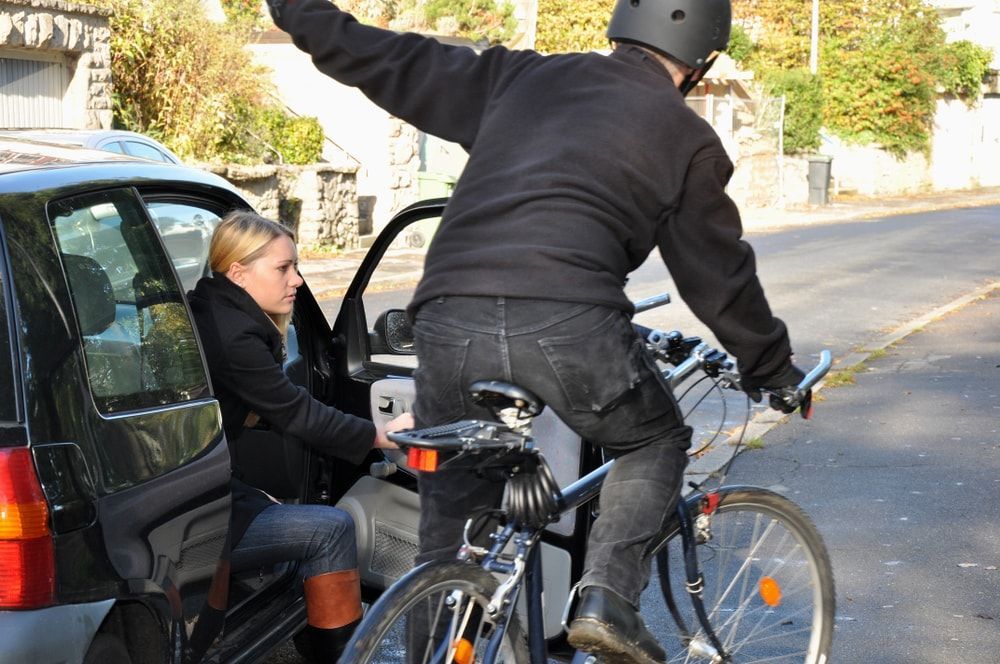
When drivers fail to scan their side-view mirrors before opening their car door, they essentially wield their door as a deadly battering ram. The approaching cyclist has no warning that a car door is about to be flung open and into them.
To prevent dooring, drivers are encouraged to use the Dutch Reach approach to opening their door. When exiting a vehicle, instead of using your nearest hand to open the door, use your far hand. This action naturally turns your body, forcing you to spot approaching cyclists before fully opening the car door.
- Over 600 cyclists per year are struck by an opening car door, according to estimates.
- These "Dooring" incidents often result in severe injuries like shattered limbs, spinal trauma, and traumatic brain injuries.
Why do Cycling Deaths continue to Rise?
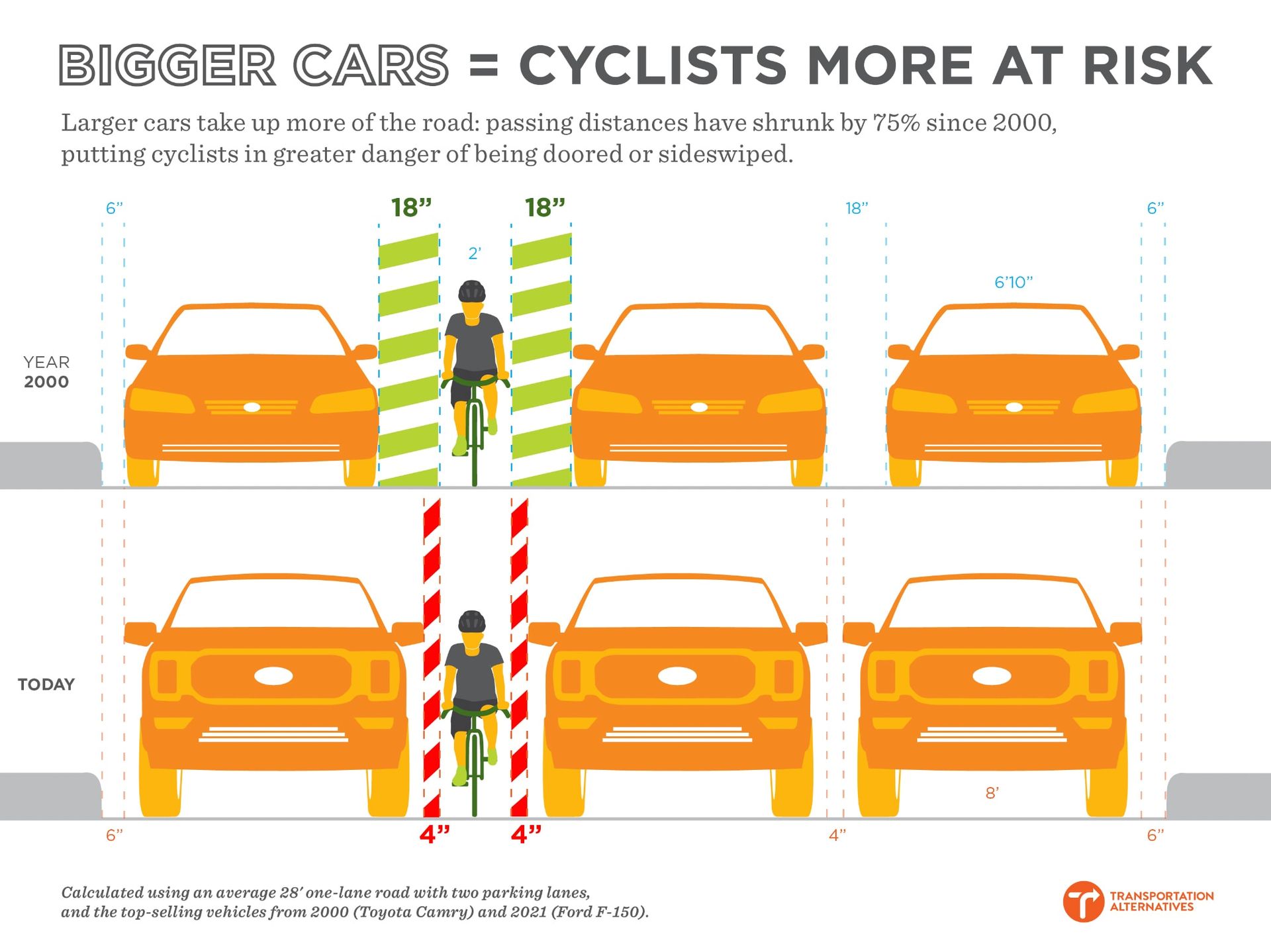
While the statistics paint a grim picture, the continued rise in cycling deaths across the U.S. can be attributed to broader systemic issues and trends that have long prioritized vehicle traffic over the safety of vulnerable road users like cyclists. Some key factors contributing to this ongoing crisis include:
- Auto-centric infrastructure design: Roads and transportation networks in many cities are still predominantly designed with the convenience of motor vehicles in mind, often neglecting dedicated space and protection for cyclists. This forces riders to share lanes with larger, faster-moving vehicles, increasing collision risks.
- Growth of larger vehicles: The popularity of larger pickup trucks, SUV's, motorhomes, and vehicles towing large trailers have effectively shrunk the already limited space available for cyclists on roads. This shrinking road space no longer allows for sharing the road safely and forces cyclists and motorists into dangerous situations.
- Lack of traffic calming measures: Without robust implementation of measures like reduced speed limits, speed bumps, and protected cycling infrastructure, vehicular traffic frequently maintains speeds that are unsafe for sharing the road with unprotected cyclists.
- Distracted driving behavior: The prevalence of mobile device use and other distractions behind the wheel has made it increasingly difficult for drivers to remain alert and anticipate the presence of cyclists, who are far more exposed to collisions.
- Cultural biases and lack of education: Deep-rooted societal attitudes that prioritize personal vehicle convenience over cyclist safety, coupled with insufficient driver education on safely sharing roads, perpetuate behaviors that endanger riders.
Reversing the alarming rise in cycling fatalities will require a multi-pronged approach that fundamentally shifts priorities and infrastructure to account for the vulnerabilities of cyclists while fostering a cultural shift toward ensuring their safety as legitimate road users.
Measures to Decrease Bicycle Accident Injuries and Fatalities
To reverse the alarming upward trend in bicycle related injuries and fatalities, a multi-faceted approach involving policy changes, infrastructure improvements, education, enforcement, and technological advancements is crucial:
- Policy & Infrastructure:
- Implementation of reduced speed limits in urban, residential, and high-risk areas for cyclists can prevent severe injury in collisions.
- Development of an interconnected network of protected bike lanes, separated from vehicle traffic wherever possible.
- Adoption and enforcement of safe passing laws (e.g. 3-foot minimum) to guide motorists on sharing the road safely.
- Better lighting, signage, and road maintenance to improve visibility and cycling conditions.
- Education & Enforcement:
- Robust educational campaigns teach motorists and cyclists alike about road-sharing responsibilities and laws.
- Stronger enforcement of traffic violations like distracted driving, impaired driving, and failure to yield that endanger cyclists.
- Vehicular Technology:
- Incentivizing the adoption of advanced driver-assistance systems like automatic emergency braking that can detect bicycles.
- Expanded deployment of camera/sensor systems to eliminate vehicle blind spots around cyclists.
- Vehicle design prioritizing improved sightlines and minimizing front blind spots.
- Bicycle Technology:
- Wider availability of radar/sensor systems to alert cyclists to approaching vehicles.
- Better lighting, cameras, and communication devices for cyclist visibility and awareness.
- Continued improvement and adoption of protective gear like reinforced helmets.
By implementing a comprehensive strategy targeting roads, laws, education, enforcement, and vehicle/bicycle technologies, cities and states can start making their streets safer for cyclists and all road users. A cultural shift prioritizing cyclist safety is also imperative.
What You Can Do To Stay Safe on Two Wheels
To keep other cyclists from becoming the next bicyclist fatality statistic, Bike Legal strongly recommends cyclists:
- Follow all traffic laws. Running stop signs or weaving in/out of lanes provokes rage in drivers already apathetic toward pedestrians and cyclists.
- Wear highly visible gear. Brightly colored clothing with reflective strips lets motorists spot you sooner, giving them more reaction time.
- Use headlights/taillights. Inadequate lighting ranks among the top contributing factors in deadly motor vehicle traffic crashes involving bicyclists, especially at night.
- Remain Alert. Remaining alert to surrounding sights AND sounds is vital to anticipating emergencies.
- Wear a helmet. Bicycle helmets reduce severe brain injury risk by 50% during an impact. It's the easiest way to improve injury prevention and survival odds.
- Plan routes strategically. Map low-traffic streets with designated bike lanes and avoid riding during peak travel times if possible.
- Ensure proper UM/UIM insurance - Bike Legal highly recommends this coverage to protect yourself from uninsured/underinsured drivers.
- Ride defensively at all times. Assume you're invisible to motorists and ride in a manner ready to evade inevitable lapses.
- Use hand signals - Clearly signal your intentions to turn or change lanes to drivers around you. Read about Hand Signals every cyclist must know here.
Injured in a Cycling Accident? Bike Legal Fights for Your Rights
The staggering cyclist fatality rates highlighted here underscore the dangers riders face every day from negligent drivers. If you or a loved one has been injured or killed in a cycling accident, you deserve justice.
Bike Legal is the nation's leading legal advocate for injured cyclists. Our experienced attorneys specialize in bicycle collision cases, aggressively pursuing maximum compensation and holding negligent parties accountable.
For a free, no-obligation consultation with our dedicated bicycle accident lawyers, please call us today at 877-BIKE LEGAL (877-245-3534) or complete our online contact form.


